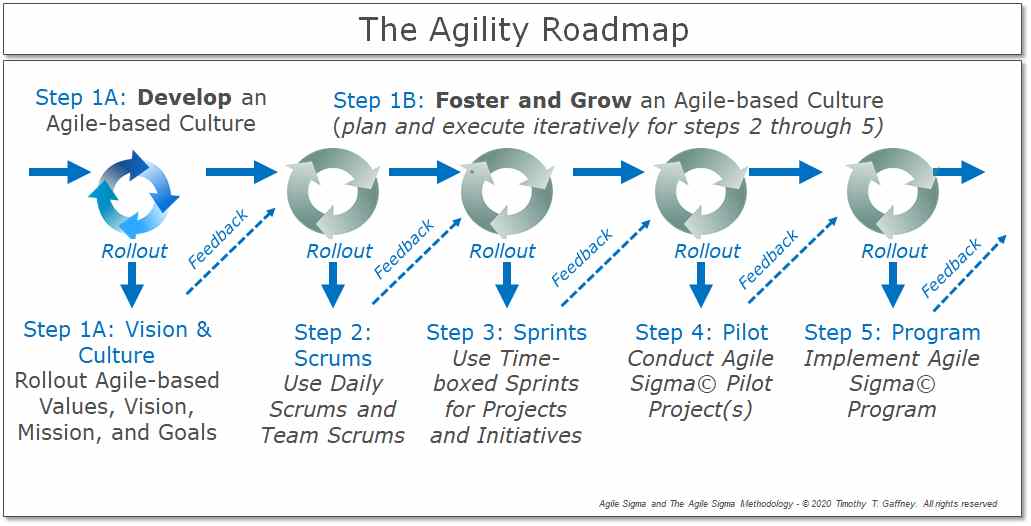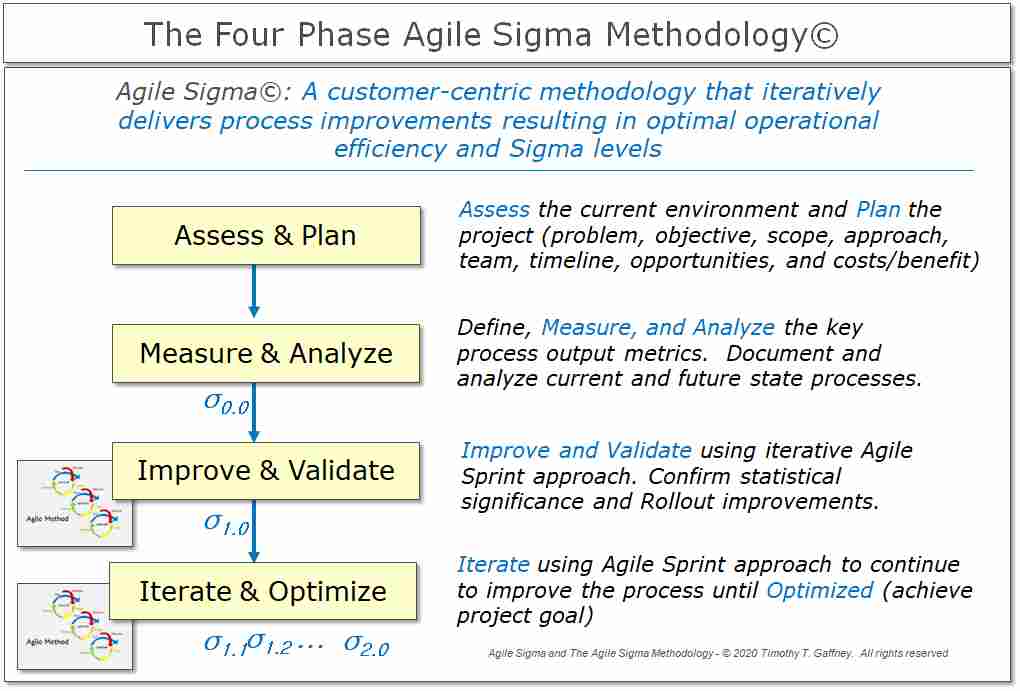Making Your Organization Agile: Getting Your Hands Dirty
Learn a step-wise process for using Agile-based ceremonies, artifacts, and methods. You'll know how to develop an agile culture in your response to your customers’ changing needs.
Follow these steps for iterative, quick, and effective improvement in your organization’s processes. Plus, you'll find it easier to accomplish a project and operational goals as a team.
In the first part of this two-part article. We discussed the first two steps on the road to agility. This final part contains the remaining three steps.
These steps when followed will help your team roll out agile-based tools and infrastructures that will enable them to perform with agility every day.
RECAP
In Part One, we defined Agility and discussed the criteria that reflect your Organisation’s Agility (As re-stated below):
If you can use your organization’s intelligence and capabilities to respond quickly to changes in business conditions - then you have Agility. In sports, you show agility by timely changing your direction, velocity, and altitude in response to a stimulus. Likewise in business, we improve processes that are impacted by many internal and external stimuli.
The Road to Agility (More Recap)
The Road to Agility begins with rebooting and rolling out agile-based values, vision, mission, and goals. As seen in Step 1A, you must do this to begin developing an agile-based culture throughout your organization.
See Figure 1 below.
Figure 1: The Agility Roadmap provides the step-by-step guide to achieve Agility

In Step 1B, we continue by fostering and growing our agile-based culture using Scrums (Step 2) and Sprints (Step 3). Steps 4 and 5 will then help you build on your previous efforts by launching a pilot and full program. This action will help you drive agile-based behaviors and outcomes across the organization.
These Road to Agility steps focuses on providing your organizations and teams with some necessary tools. These tools enable agile responses to change in customer needs and business conditions.
In Part 1 of this article gets you started with Steps 1 and 2.
While Part 2 discusses the remaining steps along the path to achieving agility for your organizations, teams, and customers.
Step 3: Use Time-Boxed Sprints
OBJECTIVE: To strengthen agile-based capabilities gained through Scrums. Also, to foster the adoption and growth of more agile values. These values create a team-based culture of change shown in the way your team accepts and responds to changes, feedback, and improvements.

Teams use a form of Agile ceremony known as a time-boxed “Sprint.” It’s used to break down tasks into practicable accomplishments in a fixed timeframe. Thus, making the project goals achievable.
Normally, organizations conduct Sprints in sequences to achieve the project goal through the sum of all underlying sprints. Mathematically, the sum of all Sprints equals the total project scope.
A project team can use Sprints to achieve their goals. You can achieve that by:
- Creating a series of activities to quicken performance
- Boost team-driven innovation, and
- Respond swiftly to changing customer needs.
Sprints generally last one or two weeks depending on the strength of the team and the nature of the project. Teams can break down their work scope into practicable Sprints to accomplish the main goal regularly.
A key benefit of Sprints is that it monitors results after each Sprint. Whereas, most traditional projects deliver all results at the end. of. This ability to track improvements helps to build a flexible agile culture.
Figure 2: The Sprint (an Agile Ceremony) can be used by Project Teams or Organizational Teams

As shown in Figure 2 above. Sprints start with a Sprint Planning Meeting (another Agile ceremony). The aim is to itemize parts of the total work scope that the team will accomplish in time-boxed sprints.
The team allots time for each item in the work scope. Once they agree on these items, they’ll pursue goals harmoniously (Note: The Sprint work items are referred to as the “Sprint Backlog” in Agile terminology).
Figure 3: Daily Scrums are used during the Sprint to create an iterative daily rhythm

Daily Scrums are held throughout the Sprint duration. This will help the team track it's progress and makes necessary adjustments as shown in Figure 3. When you practice both Agile ceremonies (Daily Scrums and Sprint), you’ll greatly improve the Agility and customer responsiveness of the team.
At the end of the Sprint timeframe (as shown in Figure 3) the team holds a Sprint Review Meeting to evaluate results in line with the Sprint goals. They then analyze these results and use them as input into rollout plans. They can also serve as input for planning the next Sprint.
In the Sprint Retrospective Meeting, the team studies the methods of interaction during the Sprint. This study helps to identify process changes necessary for future improvements.
You schedule Sprints in sequences to accomplish the overall project or the scope of work. With each successive Sprint, the team is able to deliver the Spring goals by working together. This is honed from the outcomes of retrospective meetings from previously held Sprints.
Figure 4 below shows how sprint influences a project schedule successfully.
Figure 4: Example Project Schedule broken-down into 4 successive Sprints to achieve project goals

Sprints aren’t for project teams alone. Organizations can also accomplish goal-related tasks with Sprints. Using simple agile methods (Sprints) for their projects, they can break down their overall scope of work into practicable goals with time-frames.
Step 4: Plan and Execute Agile Sigma© Pilot Project(s)
OBJECTIVE: To strengthen capabilities gained via Scrums and Sprints. To drive decisions using facts and statistics as a structured method. To maximize agile-based efforts across the organization. To optimize processes in response to changing business needs, using pilot projects.
Push-On
Now that you are seeing progress by using tile tools and techniques including Scrums and Sprints, It’s time to push on.
Step 4 deals with the planning and execution of pilot projects. We will be using agile-based methods that include fact-based decision-making.
Just like my other article title “Everyone Can Play - Agile’s Not Just for IT Anymore”, Figure 5 below describes such methods. You can use the Agile Sigma© method as the model for steps 4 and 5. However, you can apply these steps to any agile-based method to aid your Organisation in reaching its peak of Agility.
Figure 5: The Agile Sigma Methodology© Defined

The Agile Sigma© program and pilot projects provide a structured foundation and infrastructure. This level is enough to help you realize the full benefits of being Agile. You can deliver optimal results for critical corporate-wide projects and initiatives by:
- Integrating the use of agile techniques with a standardized project approach
- Using statistical analysis as the basis for data-driven and fact-based decision making.
The following provides an overview of activities involved in using an Agile Sigma© Pilot Program to test and confirm agility. It tests the new agile-based business process improvement method via pilot projects.
PLAN:
- Assign the Agile Sigma© Pilot Program Director
- Develop and Review an Agile Sigma© Pilot Program proposal.
- Seek approval and initiate the establishment of the Agile Sigma© Pilot Program including
- Staffing: Define Pilot Program positions
- Infrastructure: Establish infrastructure, test or parallel process environment and facilities
- Communications: Establish leadership communications and update processes.
- Training: Obtain Agile Sigma© Methodology, Toolkit, and Training for Pilot Program.
INITIATE:
- Collect input to identify and evaluate potential pilot projects.
- Select one or two Pilot Projects to improve processes that will eliminate the most customer “pain.”
- Proceed with staffing and assigning the Pilot Project Teams and Project Leadership roles
- Arrange and obtain Agile Sigma© Training.
EXECUTE:
- Agile Sigma© Green Belts conduct the pilot projects based on the Agile Sigma Methods©.
- Conduct Phase Reviews at the end of each of the four Agile Sigma© project phases as summarized in Figure 6 below. This further confirms that the project is on track to deliver value to customers, through statistically significant improvements of processes.
Figure 6: The Four-Phase Agile Sigma Project Methodology – a streamlined Six Sigma + Agile approach

To plan, launch, and support a full program, you'll be needing:
- Centre of Excellence
- Program Management Offices, and
- Project Management Offices (PMOs)
- Support staff
- Documentation libraries
- Toolkits
- Project repositories
- Financial tracking applications, etc
This will enable project and organizational teams to reach their goals and operate with agility.
You can also launch a corporate-wide program tailored for your specific business unit(s). Albeit, you’ll need a larger scale of these same activities for that.
You can add the Agile Sigma© as a supported method to your existing program if you have:
- A Six Sigma Centre of excellence
- An Agile Centre of excellence, or both
This is possible because the skills and processes of the Agile Sigma© project overlap with that of Six Sigma. And this affects Black or Green belts, Process Owners, Agile Scrum Masters, Product Owners, and project teams.
Implementing Agile Sigma© as an extension of an existing Six Sigma or Agile program will ease the process of implementing its program. The existing program(s) can, therefore, provide a baseline for measuring the performance and efficacy of the Agile Sigma© projects and programs.
So, there you have it!
Those are the steps along the Road to Agility. The next agile thing to do is to iterate. This entails revisiting your values and goals to ascertain performance.
Then, refine them based on the inputs you’ve received so far. Make all necessary adjustments to enhance your agility.
Take our Agile Scrum Master training. Get certified.